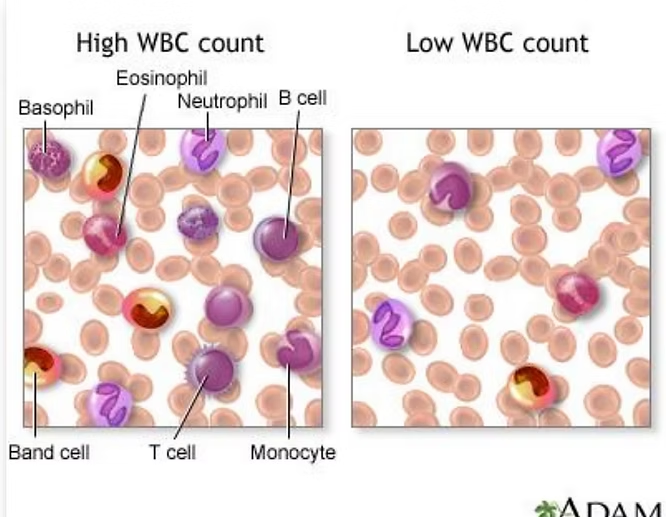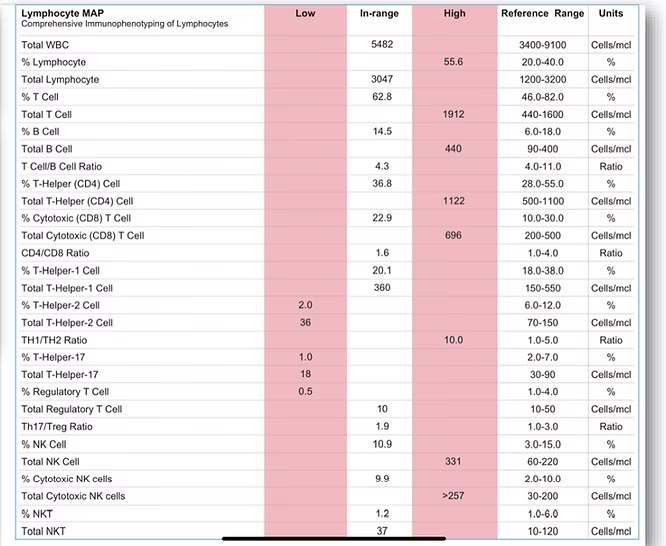Your white blood cell count plays a crucial role in your immune system’s functioning. Some individuals may have higher counts, while others have lower counts. The prevailing notion suggests that this range is normal for each person, but it may not always reflect optimal health. Unfortunately, many individuals go for extended periods with improper white blood cell counts without realizing the potential underlying issues.
Identifying Abnormal White Blood Cell Counts through Blood Work
To determine any potential causes of abnormal white blood cell counts, detailed blood work is essential. By examining blood samples, healthcare professionals can assess the precise count and identify any deviations from the optimal range.
What is a White Blood Cell Count Normal Range?
While most lab reports indicate a “normal” range of 4 to 11, the ideal range, often referred to as the “sweet spot,” lies between 5 and 6.5.
Even slight variations from this range can be indicative of underlying health conditions. For instance, a reading of 7 suggests a mild condition that might be raising the white blood cell count. On the other hand, a reading of 4.5 – which would constitute a low white blood cell count – may indicate a chronic infection weakening the immune system. It’s important to note that white blood cell count comprises various categories, including neutrophils, lymphocytes, monocytes, eosinophils, and basophils, each serving distinct functions within the immune system.
Exploring the Different Types of White Blood Cells and their Functions
What are the different types of white blood cells? Why are there so many white blood cells? And what do all the different white blood cells do?
Understanding the roles of different types of white blood cells can provide valuable insights into their significance in maintaining optimal health. Let’s take a closer look at each category
5 Different Types of White Blood Cells Names and Functions:
Neutrophils
Neutrophils combat and eliminate bacteria, as well as attack foreign debris in the body.
Lymphocytes
Lymphocytes fight against viruses and produce antibodies.
Monocytes
Monocytes play a vital role in cleaning up damaged cells. Their count significantly increases during mononucleosis (commonly known as “mono” or “the kissing disease”).
Eosinophils
Eosinophils are responsible for fighting parasites and cancer cells and are also involved in allergic reactions. Elevated levels of eosinophils often indicate the presence of a parasite.
Basophils
Similar to eosinophils, basophils are primarily involved in allergic reactions.
High White Blood Cell Counts and their Implications
An abnormally high white blood cell count signifies an excessive number of white blood cells in the body. This can involve one or more individual types of white blood cells or even all of them. When the immune system is suppressed, it leads to lower levels of these cells, which puts individuals at greater risk for various diseases.
The Composition of Blood and the Importance of White Blood Cell Count
During blood tests, samples are spun in a machine to separate the different components. On average, red blood cells make up around 45% of the blood composition, while plasma, the fluid containing water, salts, minerals, and proteins, constitutes the remaining 55%.
What percent of blood is white blood cells?
Notably, white blood cells account for merely 1% of the overall blood composition. Consequently, the white blood cell count plays a critical role in maintaining the body’s immune response. Any imbalance, especially a low white blood cell count, can have significant negative consequences.
These consequences include an increased risk of autoimmune diseases, autoimmune diseases themselves, an overactive immune system, or a weakened immune system.
Individuals with autoimmune diseases often experience dysregulation in their white blood cell counts. Identifying the cause of this dysregulation is essential for effectively addressing their health conditions. Comprehensive testing, including advanced analysis of white blood cell counts and lymphocyte subcategories, can provide a clearer understanding of the dysregulation and guide appropriate treatment.
Advanced Testing for Precise Analysis of White Blood Cell Counts
In recent years, more advanced testing methods have emerged, enabling a more detailed breakdown of white blood cell counts. This testing also extends to lymphocyte subcategories, such as T cells, B cells, T-Helper (CD4) cells, and Cytotoxic (CD8) cells. By delving deeper into these levels, healthcare professionals can better comprehend any dysregulation and determine appropriate interventions.
This is important because not all low white blood cell counts are the same. Some might be low in one subcategory versus another, so it’s essential for people with low white blood cell counts to get advanced testing to better understand their health and the possible limitations of their immune systems.
Is a low white blood cell count serious?
The most common reason for low white blood cell count is recent infection. After your body clears an infection, your white blood cells may have a temporary dip after having had a high white blood cell count to handle the infection. This is how the immune system is supposed to recent. In this case, a low white blood cell count is not dangerous or an indication of a serious disease.
The Neglected Impact of Chronic Conditions on White Blood Cell Counts
Unfortunately, many individuals suffering from chronic conditions fail to investigate the underlying causes affecting their bodies. Patients with chronic conditions often display lower or low white blood cell counts.
What is a dangerously low white blood cell count?
If your white blood cell count is chronically low under 4 thou/uL, this could be a sign of a more serious condition. This emphasizes the importance of thorough investigation and tailored treatment to address their unique health needs.
Common Causes of White Blood Cell Dysregulation
Various factors can lead to abnormal white blood cell counts, either too high or too low. Some common causes of low white blood cell counts include autoimmune diseases, low vitamin D levels, food and gluten sensitivities, pathogens, such as Lyme and mold, high insulin levels, hyperglycemia, hypoglycemia, stress, chronic inflammation, low hormone levels, low testosterone, yeast infections, Candida overgrowth, C. difficile, H. pylori, poor detoxification, chronic infections, leaky gut/brain, and dietary protein issues.
You and your healthcare provider should also look at what other symptoms you are experiencing alongside the low white blood cell count to help identify the potential causes. Then, tests can be done to understand the root causes of your white blood cell dysregulation.
The Need for Comprehensive Testing and Personalized Treatment
It is crucial to conduct comprehensive testing to identify the specific causes of white blood cell dysregulation. Unfortunately, the conventional healthcare system often fails to delve deeply into the underlying issues. As a practitioner, I prioritize thorough examination and collaborate closely with my patients to gather concrete data. By doing so, we can develop a guided path to wellness, providing hope for individuals struggling with their health.
Remember, there is always a light at the end of the tunnel, and with professional guidance and support, you can regain control over your health and well-being. I am here to help you on your journey towards optimal health, offering personalized care and empowering you to achieve lasting wellness.
VIDEO TIME STAMPS
[00:00:00] Hey, community, there’s Dr Hugh Wegwerth
[00:00:15] high white blood cell count or white blood cell count low
[00:01:15] white blood cell count high at 5.7
[00:02:00] potential low-grade mild infection
[00:02:15] longstanding systemic infection
[00:03:00] neutrophils, lymphocytes, monocytes, eosinophils, and basophils
[00:04:00] neutrophils is really for bacteria
[00:06:30] is your immune system
[00:06:45] autoimmune disease or an increased immune system
[00:09:00] high white blood cell count
[00:09:45] here. They consider the normal range 3.4 to 10.8.
[00:10:00] homeostasis immune system and that range is 5.0 to basically 6.5.
[00:11:15] Here’s another one. 9.8, This is lab high white blood cell count.
[00:11:45] This person is 2.5. So that’s a really, really low white blood cell count.
[00:12:30] We have 3.3. You can see the range in here. So 3.3, that’s also a white blood cell count low a little bit
[00:14:15] We have T cells, we have B cells, we have T helper cells.
[00:14:30] We have cytotoxic, cytotoxic CD 8 cells.
[00:14:45] different autoimmune diseases, diseases you could have a
[00:15:00] White blood cell count low can indicate a suppressed immune system.
[00:15:45] sweet spot, I like it to be 5.0 to 6.5 right here
[00:17:00] You might have an autoimmune disease, you might have low vitamin D
[00:17:15] might have food sensitivities
[00:17:30] People have chronic conditions generally create low white blood cell counts.
[00:17:45] mold, guess what happens. High insulin levels, hypoglycemia
[00:18:00] pre-diabetic stress. chronic inflammation
[00:18:15] low in DHEA or progesterone or testosterone or estrogen.
[00:18:30] leaky gut, maybe have leaky brain
Frequently Asked Questions (FAQ)
While labs typically show a "normal" range of 4-11 thou/uL, the optimal range for immune health is a tighter "sweet spot" between 5 and 6.5. A count consistently outside this range—even if within the broad "normal"—can indicate an underlying issue, such as a chronic infection (if low) or an active inflammatory condition (if high).
A temporary low count after an infection is normal. However, a chronically low WBC count under 4 thou/uL can be a sign of a more serious condition. It often signifies a weakened immune system, which increases the risk of infections and is commonly linked to autoimmune diseases, where the immune system is dysregulated.
Causes are varied and often interconnected. They include autoimmune diseases themselves, chronic infections (like Lyme or mold exposure), vitamin D deficiency, food sensitivities (especially to gluten), chronic stress, hormonal imbalances, blood sugar dysregulation (high insulin), and gut health issues like Candida overgrowth or leaky gut.
A standard WBC count is a total of five different cell types. Advanced testing breaks down the count into subcategories (like neutrophils, lymphocytes, T cells, and B cells). This is crucial because a deficiency in one specific type (e.g., lymphocytes that fight viruses) points to a very different root cause than a deficiency in another, allowing for a precise and personalized treatment plan.
Autoimmune diseases involve a dysregulated immune system that attacks the body's own tissues. This constant state of activation and confusion can lead to exhaustion and depletion of white blood cells over time. Therefore, a chronically low WBC count is not just a symptom but a key indicator of an overworked and compromised immune system often seen in autoimmune conditions.












